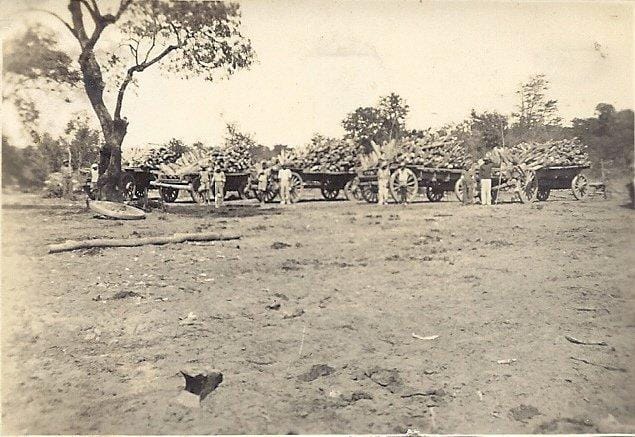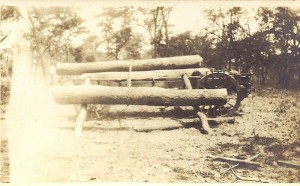Muscle and Wood Power

Gervas Hughes had eleven sixteen foot bullock wagons that transported firewood to the G and P mine. Three cords made a load. – See more at: https://www.oncecalledhome.com/2012/12/muscle-and-wood-power/#sthash.JMvgZ77s.dpuf
Muscle and Wood Power
By now, besides Brian Freyburg, Gervas Hughes had about a hundred Native employees on the farm. They all worked six days a week. Sunday was a rest day for the men and the only day for Gervas to do his office work. He’d visit the Standard Bank in Que Que at the end of the month to get cash in the required denominations. They were paid through the farm office window.
They always herded the cattle, as there were no paddocks. Gervas’ punishment for a herdsman who lost cattle was to draw a circle a couple of feet in diameter in the dust, outside the office door, and give him two grasshoppers to herd in the circle, much to the herdsman’s shame and the amusement of visitors to the office.
Muscle and Wood Power
Brian’s work centred on Gervas’ transport business; eleven sixteen foot bullock-wagons and town mule-carts. He always worked ten wagons, with the eleventh spare or under repair. Each had a span of eighteen oxen, yoked in pairs, a spare span, plus nine extra in case of sickness. When not working, the oxen were herded to water and grazing, and returned in the evening and tied to their yokes for the night, ready to be inspanned by daylight next morning, when the wagon was loaded up to take timber to a mine.
A day’s trek, loaded, could not be more than ten miles. Each span was matched by colour, size, and shape of horns. The leading yoke and wheelers were very highly trained for their jobs. Each wagon had a driver with a long whip like an overgrown sea casting rod with a long lash. A good driver was supposed to be able to kill a fly on the neck of a leading ox with his whip. There was also a man on foot to guide the leading yoke.
At first light, the driver and leader inspanned the oxen and drove the wagon to where the wood was cut and stacked in cords. On hundred and twenty cubic feet of firewood made one cord, cut in four foot lengths. In dry weather three cords made a load. A wood cutter had to cut a cord with a four and a half pound axe, and stack it, every day. The driver and leader loaded their wagon and also unloaded it at the mine. There a mine employee placed the wood in long stacks, to dry out for a month, before it was used to heat the boilers. The empty wagon was driven back to camp, for the process to be repeated, five days a week. On Saturdays all the cattle were dipped to rid them of ticks, wagon axles were greased, and any running repairs carried out.
Barbara didn’t see much of Gervas during the day.
Many Thanks to Tim Hughes of Queensland, Australia for the picture and the excerpts from his unpublished manuscript Matambega and Son written in the 1980’s.

